An All-Around Theater Man

Dariela Aquique
HAVANA TIMES – Scene design is an art of visual perception in which the individual creates and recreates natural or fantastic worlds. It makes use of different techniques that allow feelings, emotions and ideas to be expressed, using drawing as a fundamental basis. I’ll be talking about this topic with the scene designer and creator Eduardo Gaspar Guasch Estuí.
HT: Can you tell us about your beginnings in this artistic environment?
EG: Since the time I studied at the Superior Art Institute (ISA), by being in Havana, where cultural life is very rich, full of many exhibits, concerts, theater premiers, I became fascinated by the world of theater. I would go around with the performing arts students all the time, to the point where everyone thought I was studying theater, and not visual arts.
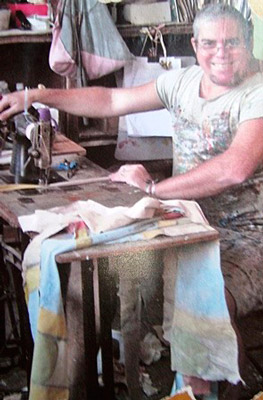
I didn’t succeed in graduating from the ISA because I failed English. They made me do the year over; I got discouraged, and didn’t continue on. But I stayed in Havana and started working as a graphic design creator on the 21st floor of the FOCSA building.
In 1986, I went to Santiago de Cuba on vacation and the Guiñol Santiago theater troupe invited me to design a show, and that was my first design for theater.
In those years, I did mainly wood carvings, and I started participating in exhibits and events in Pinar del Río, Guantánamo and Matanzas. I kept working in the City of Bridges (Matanzas) designing theater productions with the Bumm theater troupe.
At that stage, until 1992, I also worked with the Guiñol de Guantánamo. I designed for the Guiñol Santiago again. I also worked with the Artistic Group of the Revolutionary Armed Forces (FAR) in Sabaneta, between Moa and Guantánamo. I was even something of a theatrical actor over there, until I settled down in Santiago with the Guiñol.
HT: The Guiñol Santiago Theater is a compulsory reference as a professional troupe. It was founded more than 50 years ago. It’s the only theater for children in the city, and for many years it was the most important theater in the entire eastern region. How did you start working with Guiñol?
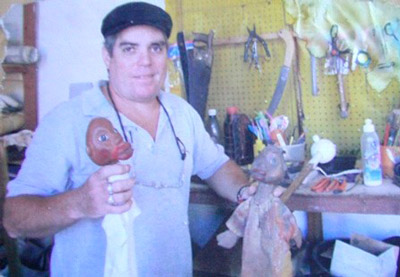
EG: I came to Santiago de Cuba in 1986 during vacations, and Ramón Pardo, who was then director general of Guiñol Santiago, invited me to design a play. I remember that it was called Naughty Little Dog (Perrito travieso). And in 1989, during other vacations, they called me up again and I designed my second show Bibí. In 1992, they hired me as a stagehand and I designed and created the production for my third show with Guiñol Santiago. And that’s how I’ve been here for 21 years out of the almost 27 years that make up my career in performing arts.
HT: In the 1990s, the adversity of the special period, and the lack of all sorts of materials also affected theatrical productions. How would you go about designing and creating costumes, props and the plays’ scenographies?
EG.: In 1992, the Guiñol was working on the stage production of Chichiricú de la charca, a play with a setting that has to do with Afro-Cuban folklore. And Raymond, another designer who from the beginning was in charge of the set design, didn’t really know what to do faced with so many resource shortages. I began working with them then, and proposed using organic materials like palm leaves, dried leaves, the use of rope, and burlap. People would give us pieces of fabric, a little paint. In those days, there was more solidarity than today, and that’s how we would find solutions. I received royalties, and with that money (my money), I would buy materials for the following productions. And I still do this, because much of the time we’re missing this or that…
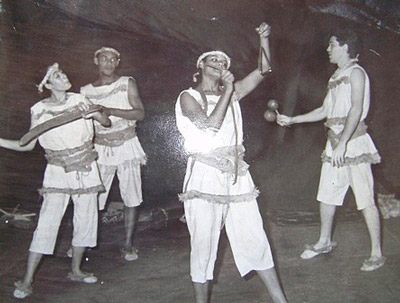
What’s funny is that economic insecurity made us improvise. For the first time the Guiñol Santiago had a set design with which it was identified for a long time.
HT: You design plays for children, but also have designed and created dramatic theater productions. Tell us about that.
EG.: Though people always associate me with children’s theater, I’ve designed more dramatic theater than plays for children. It must be that since I work for Guiñol, people always associate me with puppets, but I’ve designed for all the dramatic theater troupes that have existed in this city. I’ve even worked with dance groups, with the Conjunto Folclórico de Oriente. I also designed a play for adults with you, Dariela, one that you directed in 2007.
HT: What organizations or institutions have you joined to be able to work or to receive your royalties?
EG.: Well, I’m currently a member of Cuban Writers and Artists Association (UNEAC), which, for a long time, was the entity responsible for processing royalties for copyrights and all that bureaucratic paraphernalia. It’s not like that anymore. There’s an institution called the Center for Development of the Visual Arts (Centro de Desarrollo de las Artes Visuales), which is located in Old Havana and authorizes me to have an account where I can receive my royalties. I have a card and a document that’s a kind of safe-conduct that I have to renew from here via the Provincial Council for Visual Arts (Consejo Provicial de las Artes Plásticas) and that way I can receive the money.
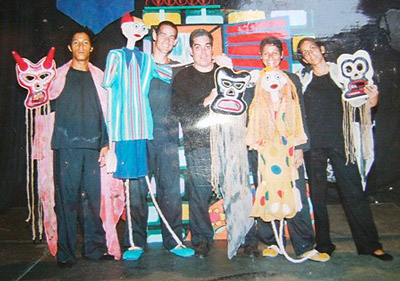
The exhibits are easier to coordinate. If you’re a professional artist, associated with certain entities, it’s not that hard to expose your work.
HT: How many plays have your designed over the course of your career?
EG.: I’ve designed 45 shows, of which some dramatic theater and children’s theater, and one dance show.
HT: Do you consider yourself a visual artist or an all-around man of theater?
EG.: An all-around man of theater, without a doubt.
HT: Have you had any experience with television or film?
EG.: In 1999 I had an experience as a supporting actor (with lines), in Caribe, an Italian-Cuban coproduction. My character was second mate on a French boat.
In 2000, I also had an experience in television as an extra in the adventures The Cave of Mysteries (La cueva de los misterios). I played a Spanish soldier. And in 2004, I designed the puppets Colorimágico, a children’s program that airs on Santiago de Cuba’s television channel.
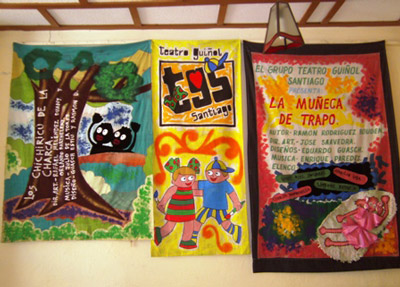
HT: Eduardo, you’ve gotten to take part in marvelous times for creation and scene production in Santiago. Many people from your generation emigrated to Havana or other countries, but you stayed. Why?
EG.: Actually, I never thought of leaving this place. I love Santiago de Cuba, but right now a series of circumstances and the artistic insensibility of some of the staff that manages human resources, bureaucratic issues, and other issues, have produced great disappointment for me.
And you’re getting the first glimpse of this in your interview. I’m working on going to live and work in Havana. Leaving Cuba definitively, I never thought of that either. But leaving here to get to know different parts of the world, of course.





